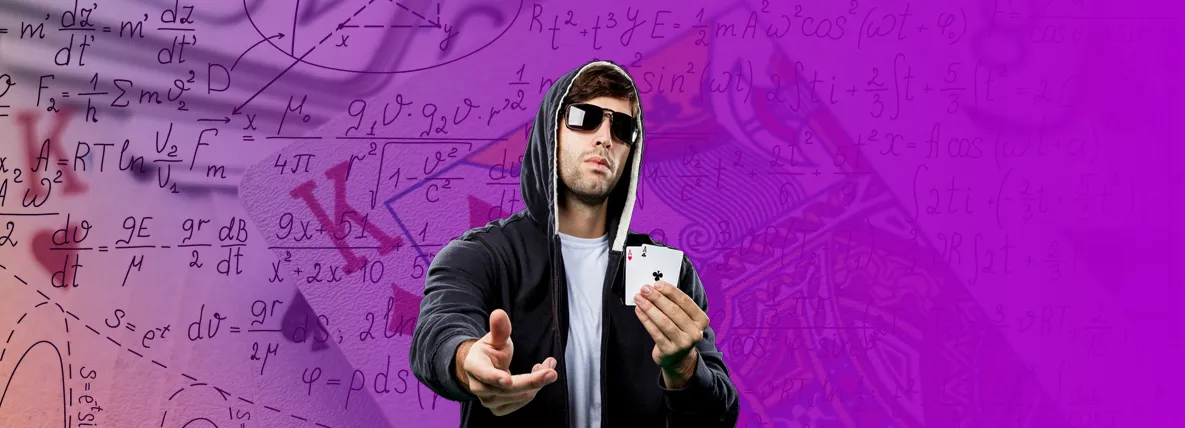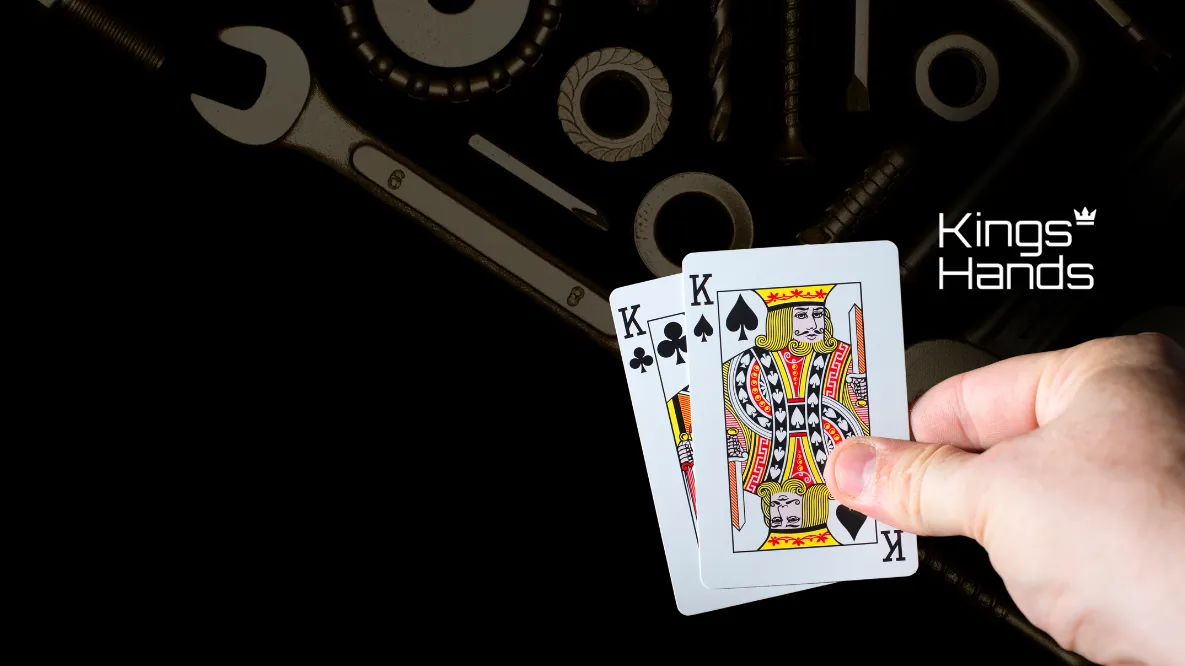In our last poker math article, we explored the EV of bluffing with a hand that has no chance of winning. However, what if we’re bluffing with a draw that has a chance of making the best hand? How does that impact the EV of our bluff?
In this article, we’ll be looking at how to calculate the EV of bluffing with draws, why it’s useful, and much more!
***Please note, to emulate how these calculations will work in-game, we’ve calculated the odds of improving using the Rule of 2 and 4 which you can find in our poker outs and probabilities article. If you want to learn the exact chances of improving for common scenarios, make sure you check out our poker odds cheat sheet at the bottom of the page!***
Why Is It Useful To Know Our EV When Bluffing With A Draw
While our outright bluffing EV calculation is all well and good, it’s only really useful for hands that have no chance of winning. When we have a hand like a flush draw, we have a chance of making the best hand and winning the pot at showdown. This equity needs to be considered in our EV calculation to determine whether or not we have a profitable bluff with our draw, which is why we use a separate equation.
How Do We Calculate The EV Of Bluffing With A Draw
Those of you who read our last article will recognise the similarities between this equation and the outright bluffing EV equation. However, the equation has been modified to include the outcome of when our opponent calls and we win, which gives us a more accurate idea of our EV.
Let’s take a look at how it works.
BWD EV = ((Pot Size * Fold %) + (Bet Size * (Call % * Win %)) – (Call % * (Bet Size * Lose %))
Pot Size – What is the size of the pot before you make a bet?
Fold % – How often does your opponent fold?
Bet Size – How much do you bet?
Call % – How often does your opponent call?
Win % – How often do you win when your opponent calls?
Lose % – How often do you lose when your opponent calls?
There’s quite a lot to wrap your head around, so let’s take a look at it in action.
We’re on the turn with a flush draw and are considering making a $75 bet into a $100 pot. We know we have a roughly 18% chance of making the best hand on the river, and we think that our opponent will fold around 40% of the time to our river bet. Given these variables, would our bluff be profitable? Let’s plug these numbers into our equation and take a look.
BWD EV = (($100 * 0.4) + ($75 * (0.6 * 0.18)) – (0.6 * ($75 * 0.82)
BWD EV = ($40 + ($75 * 0.108) – (0.6 * $61.50)
BWD EV = ($40 + $8.10) – $36.90
BWD EV = $48.10 – $36.90 = $11.20
After running the calculation, we can see that the EV of our $75 bet is $11.20, meaning that we have a profitable bluff with our flush draw.
However, just like our outright bluffing EV calculation, it’s important that we objectively consider how often our opponent will fold. Changing our opponent’s fold percentage drastically changes the EV of our decisions, so you must try and be as accurate as possible. Let’s look at the same scenario but with our opponent only folding 20% of the time.
BWD EV = (($100 * 0.2) + ($75 * (0.8 * 0.18)) – (0.8 * ($75 * 0.82)
BWD EV = ($20 + ($75 * 0.144) – (0.8 * $61.50)
BWD EV = ($20 + $10.8) – $49.20
BWD EV = $30.80 – $49.20 = -$18.40
Just by halving our opponent’s fold percentage, our bluff goes from having an EV of $11.20 to an EV of -$18.40!
EV Of Bluffing With A Draw In Action
Professional players use these calculations all the time while they’re playing to ensure that the bluffs they’re making are profitable. Let’s take a look at an example from High Stakes Poker where Mike Matusow faced off against Daniel Negreanu in a huge hand.
Mike starts out by limping with AcQc after a $1,600 straddle from Doyle Brunson. Three more players limp, and Negreanu raises to $16,000 with ThTc. The action folds back to Matusow who makes it $45,000, the three limpers fold, and Negreanu makes the call.
The flop comes 6h4c7c, giving Mike two overcards and the nut flush draw. There is $98,000 in the middle and the action is on Mike, who is deciding how much to c-bet. He’s considering putting maximum pressure on Negreanu by shoving his $200,000 stack into the middle. However, before he does so, he runs a quick calculation to work out the EV of this bluff.
Mike assumes that all of his flush outs are good and that his queen and ace are also good, giving him 15 outs to make the best hand. He also assumes that Negreanu will fold 70% of the time to such a big bet.
Given those assumptions, let’s see how the calculation plays out.
BWD EV = (($98,000 * 0.7) + ($200,000 * (0.3 * 0.6)) – (0.3 * ($200,000 * 0.4))
BWD EV = ($68,600 + ($200,000 * 0.18)) – (0.3 * $80,000)
BWD EV = ($68,600 + $36,000) – $24,000
BWD EV = $104,600 – $24,000 = $80,600
After running this calculation, Mike saw that he had a hugely profitable bluff with his strong draw, so he decided to shove, putting Negreanu in a tough position. After a lot of deliberation, Negreanu made the call – much to the chagrin of Matusow!
The two players ran it twice, and despite making a set on the second board, Negreanu lost both runouts, adding further evidence to his bad luck on High Stakes Poker.
EV Of Bluffing With A Draw Quiz
Now that we understand how to calculate your EV while bluffing with a draw, let’s put your new knowledge to the test with a short quiz. You can find the answers at the bottom of the page.
Question 1
You’re on the turn with an open-ended straight draw and decide to bet $50 into a $100 pot. You think your opponent will fold 35% of the time to your bet. Is this bet profitable?
Question 2
You’re on the flop with a gutshot straight draw and decide to jam your last $100 into a $100 pot. You think your opponent will fold 20% of the time to your shove. What is the EV of this shove?
Question 3
You’re on the turn with a flush draw and are deciding between two bet sizes. If you bet $25 into a $75 pot, you think your opponent will fold 30% of the time, but if you bet $100 into a $75 pot, you think your opponent will fold 75% of the time. Which bet has the higher EV?
Summary
The equation we’ve learnt is an extension of the outright bluffing EV calculation, but it’s a vital one to learn if you want to improve as a player. By including the equity of your draw into the equation, you get a more accurate estimate of your EV, allowing you to make better decisions at the table. Calculating this equation at the table may be difficult, but by working on it off the table you develop an intuitive understanding of which situations are profitable and are better able to make correct decisions in-game.
Answers:
Question 1 – Yes, this bet is profitable, as it has an EV of $12.90.
Question 2 – The EV of the shove is -$34.40, making this an unprofitable bluff.
Question 3 – The second bet has the highest EV; the first bet has an EV of $11.30, and the second bet has an EV of $40.25.





















